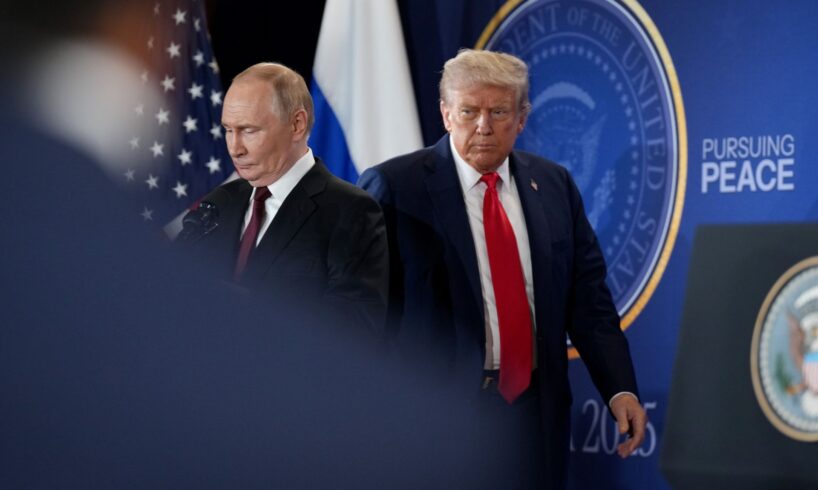
U.S. President Donald Trump (R) and Russian President Vladimir Putin (L) in Anchorage, Alaska, U.S., on Aug. 15, 2025. (Andrew Harnik / Getty Images)
As U.S. President Donald Trump accelerates his push for a settlement in Moscow’s war against Ukraine, analysts say Russia’s ambiguous stance is clouding the process.
Even though the original peace plan unveiled by the U.S. last week was skewed in Russia’s favor, it is not clear if Moscow would have accepted it since it still falls short of its sweeping demands. Observers note that Moscow has never clearly signaled readiness to accept the proposals.
“They’ve been very coy about the negotiations and what they would accept as a settlement,” Emily Harding, vice president of the defense and security department at the Center for Strategic and International Studies, told the Kyiv Independent.
There are signs that the Kremlin is not interested in a U.S.-brokered peace deal at all, with Russian President Vladimir Putin and other top officials reiterating maximalist demands and refusing to accept any compromise.
Instead of seeking peace, the Kremlin is trying to buy time and undermine Ukraine’s allies, analysts say. Another goal is to shift the blame to Kyiv by accusing it of rejecting Russian conditions that are effectively tantamount to capitulation.
Outrage, disgust, but little surprise — Ukraine reacts to bombshell Witkoff leak
Moscow’s fingerprints on the original plan
New evidence suggests that the initial version of the peace framework — the 28-point plan — was pushed directly by Moscow, despite Washington’s assurances that it was independently crafted.
In one of the conversations leaked by Bloomberg on Nov. 25, two Kremlin aides discuss having U.S. special envoy Steve Witkoff falsely present a Russian peace proposal as a U.S. initiative.
“And let them do like their own (peace plan),” Russian envoy Kirill Dmitriev said. “But, I don’t think they’ll take exactly our version, but at least it’ll be as close to it as possible.”
“Moscow knows it can have Trump’s ear.”
The framework required Ukraine to cede territory, limit alliances, and sharply reduce its army — demands tougher than those previously discussed, raising concern that Washington could pressure Kyiv into accepting a deal tailored to Moscow’s interests.
Special Envoy of the U.S. President Steven Witkoff (R) followed by Kirill Dmitriev, Russia’s top economic negotiator (C), and Kremlin foreign policy aide Yuri Ushakov (L) in Moscow, Russia, on April 25, 2025. (Kremlin Press Office / Handout / Anadolu / Getty Images)
For Ukraine, the original framework amounted to surrender.
“The 28-point plan was dangerous because most of its provisions aimed to weaken and isolate Ukraine, which risked facilitating or even encouraging further aggression,” Pierre Haroche, a European security expert, told the Kyiv Independent.
Analysts say the Kremlin’s goal was to test how far Ukraine could be pushed.
“As for the 28-point peace plan, it may be best understood as an attempt to see what Ukraine may give up when pressure is placed on Kyiv,” Oleksa Drachewych, an assistant professor of history at Western University, said.
‘Echoes of 1938’ — Trump’s peace plan undermines Europe’s security, experts warn
The Kremlin’s shifting signals
Amid all that, Moscow’s public messaging has been contradictory.
On Nov. 21, Putin said the initial maximalist proposal had been discussed during the Alaska meeting, claiming Washington asked Moscow to “show flexibility” — and that Russia agreed.
He described the 28-point draft as a “modernized” version of those earlier talks, suggesting it could serve as a basis for negotiations.
But as revisions to the plan began to take shape, the Kremlin’s tone shifted.
U.S. Army Secretary Dan Driscoll traveled to Abu Dhabi on Nov. 24 for talks with Kyrylo Budanov, Ukraine’s military intelligence chief, and a Russian delegation. Washington was expected to present the revised peace plan.
“I think Moscow is buying time in order to delay sanctions… and to adjust by finding ways to avoid damaging consequences for its economy and stability of the system.”
After consultations in Geneva on Nov. 23 between Ukrainian and U.S. negotiators, the proposal was reportedly reduced from 28 points to 19. Ukrainian President Volodymyr Zelensky said the plan was now more aligned with Ukraine’s needs.
Russian Foreign Minister Sergey Lavrov hinted on Nov. 25 that the Kremlin would not agree to the revised U.S. peace plan if it reflected Russia’s demands to a lesser extent than the original version.
“If the spirit and the letter of the Anchorage agreement have been diluted — especially in those key agreements that were established there — then, of course, we’ll be dealing with a fundamentally different situation,” Lavrov said in a reference to the Aug. 15 meeting between Trump and Putin in Alaska.
Meanwhile, Putin reiterated Russia’s maximalist demands on Nov. 27, indicating that he had little interest in negotiating with Ukraine.
He said that “signing documents with the Ukrainian leadership is pointless.”
“Of course, we ultimately want to reach an agreement with Ukraine. But right now, it’s practically impossible — legally impossible,” he said. “…I believe the Ukrainian leadership made a fundamental, strategic mistake when it was afraid to hold a presidential election, after which the president lost his legitimate status.”
Russia has been demanding an election in Ukraine in hopes to get rid of Zelensky, destabilize the political situation and potentially install Russian puppets in power, experts say. Under the martial law act passed by Ukraine after Russia launched its full-scale invasion in 2022, presidential, parliamentary and local elections are banned in wartime.
Putin also demanded that Ukraine’s Crimea and Donbas be recognized as Russian de jure internationally.
The Russian leader said that hostilities would end if Ukrainian troops withdrew from the Donbas. If they don’t, Russia will seize the territory anyway, he added.
Experts warn the revisions to the original peace plan would likely provoke a phase of obstruction from Moscow.
“Russia is likely to argue that the amended proposals represent an attempt by Ukraine and European partners to sabotage the progress supposedly achieved through cooperation with the United States,” Natia Seskuria, an associate fellow at the Royal United Services Institute, told the Kyiv Independent.
How Steve Witkoff pushed Ukraine sympathizers out of White House, and led the US into Russia’s arms
What Russia really wants
Analysts agree that Moscow’s goal is not to end the war, but to reshape the narrative, undermine Ukraine’s allies, and buy time.
Seskuria said the Kremlin is trying to portray Kyiv as the party blocking peace while advancing proposals it knows Ukraine cannot accept.
By doing so, she said, Moscow seeks to strain U.S.-Ukraine relations.
Trump echoed that dynamic on Nov. 23, criticizing Ukraine for its supposed lack of gratitude for U.S. peace efforts.
Drachewych said Moscow had occasionally persuaded Trump to adopt its conditions, leading to pressure on Zelensky to negotiate on the Kremlin’s terms.
“Moscow knows it can have Trump’s ear,” he said, adding that Russia is using this leverage to make the U.S. put more pressure on Ukraine.
U.S. President Donald Trump (R) with U.S. Special Envoy Steve Witkoff (L) in New York City, U.S. on Sept. 7, 2025. (Kevin Dietsch / Getty Images)
At the same time, Russia is attempting to fracture the transatlantic alliance that has supported Ukraine since 2022. European leaders, faced with Trump’s unilateral moves, have scrambled to coordinate responses.
According to Drachewych, Russia’s strategy allows it to pursue several objectives simultaneously: weaken U.S. support for Ukraine, divide the U.S. and Europe, and push for a security order shaped by Washington and Moscow.
There’s another layer to Moscow’s strategy. Orysia Lutsevych, deputy director of the Russia and Eurasia Program at Chatham House, said the Kremlin wants to delay new U.S. sanctions.
“I think Moscow is buying time in order to delay sanctions… and to adjust by finding ways to avoid damaging consequences for its economy and stability of the system,” she said.
The timing supports this theory. The renewed peace push came shortly after the first U.S. sanctions under Trump’s administration targeted Russian oil companies Rosneft and Lukoil in October.
Why Trump’s 28 point peace plan for Ukraine is different
What comes next
Experts doubt Moscow will accept the revised Geneva version of the plan, which now appears more acceptable to Ukraine — and that may be the point.
“It is very unlikely that they will accept (it),” Lutsevych said. “We see them pressing a maximalist agenda because Putin believes he can win this war.”
Russia has already offered a preview of its response.
On Nov. 24, Moscow dismissed a European-drafted peace proposal more favorable to Ukraine as “unconstructive.”
Kyiv’s European partners designed their draft specifically to counter the original 28-point plan, which faced withering criticism for heavily favoring Russia.
Yasir Atalan, a data fellow at the Center for Strategic and International Studies, said that, if talks continue, the U.S. plan may eventually diverge sharply from Russia’s preferred outcome.
That possibility, he said, explains Putin’s cautious tone.
Russia’s President Vladimir Putin chairs a Security Council meeting at the Kremlin in Moscow, Russia, on Sept. 22, 2025. (Alexander Kazakov / Pool / AFP / Getty Images)
Witkoff, who advised the Kremlin on how to talk with Trump, is expected to meet the Russian president next week to finalize the peace deal.
But the draft negotiated in Switzerland by Ukraine and the U.S. appears unlikely to satisfy Moscow.
“The Geneva negotiations seem to have eliminated several points (favoring Russia),” Drachewych said.
“These changes, given that they remove items that have repeatedly been part of Russia’s demands… I suspect it will lead to the eventual Russian dismissal of whatever was negotiated.”
The cycle appears destined to repeat: Moscow floats maximalist demands, the West pushes back, Russia rejects any compromise, and the war grinds on.
‘Capitulation and betrayal’ – Ukrainians react to controversial US peace plan





